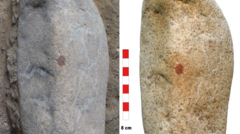Scientists in Spain have made a striking discovery that may change our understanding of Neanderthal behavior and artistry. Researchers excavating the San Lázaro rock shelter in Segovia have unearthing a pebble believed to have an imprint from a Neanderthal fingerprint, dating back approximately 43,000 years. This finding supports the hypothesis that Neanderthals engaged in artistic activities, suggesting a level of cognitive sophistication previously underestimated.
The intriguing pebble appears to be marked with red pigment, potentially from ochre, which points to the possibility that a Neanderthal dipped their finger into the pigment to create a dot that resembles a nose on the stone. According to María de Andrés-Herrero, one of the study's authors from the University of Complutense in Madrid, the "strategic position" of this dot signifies a form of "symbolic behavior," indicating that Neanderthals could think abstractly.
De Andrés-Herrero spoke with BBC’s Newsday, highlighting the excavation's five-year journey that led to this remarkable find, which lay buried beneath 1.5 meters of sediment associated with Neanderthal activity. When first discovered, the excavation team was astonished at the prominent stone bearing the red dot, which seemed to have an uncanny resemblance to a human face.
Following initial analysis to confirm the nature of the pigment, scientists collaborated with Spain's scientific police to apply multi-spectrum analysis techniques. Their investigation yielded evidence of a male adult fingerprint on the pebble. Although archaeologist David Álvarez Alonso, another co-author of the study, noted the challenges of comparing this print to known Neanderthal references, they nevertheless affirmed its significance.
Spanish official Gonzalo Santonja commented that this pebble represents the oldest known painted portable object in Europe, marking it as the singular known piece of Neanderthal portable art. The research emphasizes the cultural implications of this discovery, with Prof de Andrés-Herrero asserting that it contributes substantially to the discourse on Neanderthal symbolic capabilities.
Notably, the fingerprint was discovered in a non-utilitarian context, reinforcing the notion that the design on the pebble was crafted with artistic intent. Prof Alonso elaborated, suggesting that a Neanderthal may have been drawn to the stone's unique fissures and consciously decided to adorn it with ochre pigment—an act they believe was intentional.
The research team's conclusions, published in the journal Archaeological and Anthropological Sciences, describe the pebble as an exceptional artifact that embodies characteristics of a visual symbol often classified as portable art. The presence of red ochre at the site implies that the pigment was specifically brought to the rock shelter by the Neanderthals, further supporting their artistic engagement. This discovery not only challenges traditional views of Neanderthal intellect but also opens new avenues for reconsidering their cultural expression and capabilities.




















